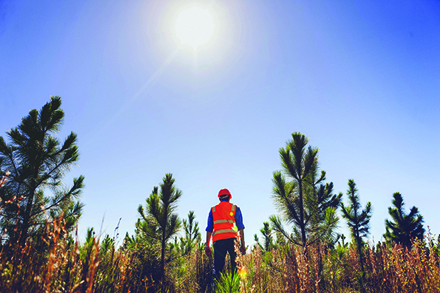
Both major political parties have committed to spend more on forestry research and development to reverse the plunge in both industry R&D spending and the number of research scientists over the past decade. Source: Philip Hopkins for Timberbiz
R&D was a key theme of last week’s forest industry debate between the Assistant Minister for Agriculture, Senator Richard Colbeck, and the Opposition Shadow Minister for Agriculture, Fisheries and Forestry, Joel Fitzgibbon. The debate was organised by the Australian Forest Products Association.
AFPA chief Ross Hampton kicked off the discussion by pointing out that in 2008, there were more than 700 researchers and technicians involved in forestry R&D, whereas now there were only about 200 “if you’re lucky”.
Mr Hampton said the Mt Gambier and Launceston research nodes (the National Institute of Forest Products Innovation centres) had run out of money after “turbocharging” $16 million worth of research, with federal and state money.
“There is a need to provide R&D for the industry,” he said.
Senator Colbeck said the Government wanted further nodes of innovation.
“We have started a further conversation with the states to co-contribute. We also want to do one in the south-west of WA and the south-east of NSW, but we can’t contract anything in caretaker role,” he said.
“We would like a conversation with the Queensland Government to focus on indigenous forestry – it’s a huge opportunity. A huge chunk of the forest estate in indigenous hands There is a big opportunity to develop employment in indigenous communities up north; $200,000 recently went through the Northern Development Fund to indigenous communities in forestry in the north.”
Senator Colbeck said the Government had a clear commitment to expand the process around the National Institute of Forest Products Innovation with Forest and Wood Products Australia.
“I’ve said before – we would like to bring all that together, harness the capabilities of NIFBIs, FWPA and industry to create something like FP Innovations in Canada. That will increase our overall R&D effort,” he said.
Mr Fitzgibbon emphasised that processors would be eligible to dip into Labor’s $1billion manufacturing fund. This will provide concessional loans to manufacturers seeking to innovate, expand or diversify.
“We will have a re-look at R&D schemes in forestry and agriculture more generally. We will spend as much as this Government but want to ensure it’s spent effectively. We will make sure we have plenty of forest-specific research,” he said.
Queried by Mr Hampton if that included the Rural and Research Development Corporation that looks after forestry and the FWPA, Mr Fitzgibbon said: “Of course, the FWPA has done a lot of great work.”
Senator Colbeck said the Government was committed to FWPA. Consultants had done a review of R&D.
“It’s worth the read,” he said, praising the RDCs that were put in place by Labor in the 1990s.
“They are a really good way to generate co-operation for R&D between government and industry. It can always be improved – some elements can be improved,” he said.
Mr Fitzgibbon said the co-funding model was the strength of our R&D system.
“That is not under question. It was a Labor model and we are proud of it,” he said. It would be given a “refresh”.
Former Tasmanian forestry chief, Terry Edwards, said as chair of the NIFBI in Launceston, he was disappointed not to have seen some commitments to the ongoing operation of the Launceston NIFBI.
“It was successful,” he said, producing more than $10 million in projects from $2 million each from the state and Commonwealth. Industry itself had decided the projects were important.
“I seriously urge both parties to commit to NIFBI – it works,” he said.
According to Australia’s 2018 State of the Forests Report, ABS data show that from 2007-08 to 2013-14, business forestry R&D spending fell from $144 million to $86 million. Separate industry surveys, using a different definition of the sector, reported that R and D fell from $88 million in 2007-08 to $48 million in 2012-13.
The estimated number of researchers and technicians in R&D declined from 733 in 2008, to 455 in 2011, and 276 in 2013. The total number of researchers employed by state and territory agencies was reported as 89.5 full-time equivalent staff in 2015-16 – about half the 171.8 full-time for 2011-12.






